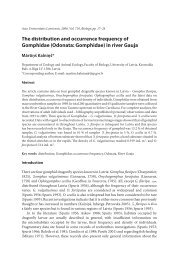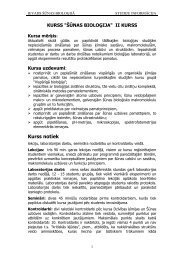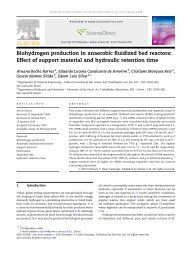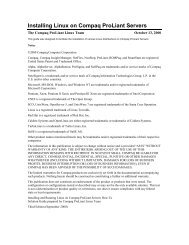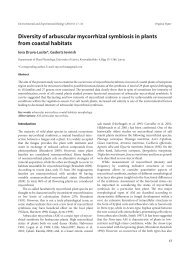Full Text (PDF) - Latvijas UniversitÄte
Full Text (PDF) - Latvijas UniversitÄte
Full Text (PDF) - Latvijas UniversitÄte
You also want an ePaper? Increase the reach of your titles
YUMPU automatically turns print PDFs into web optimized ePapers that Google loves.
Acta Universitatis Latviensis, Biology, 2004, Vol. 676, pp. 27– 37<br />
Tick-borne encephalitis – pathogen, vectors and<br />
epidemiological situation in Latvia 2002 - 2003<br />
Antra Bormane 1 , Antra Zeltiña 2 , Irina Lucenko 1 ,<br />
Violeta Mavçutko 1 , Arnis Duks 1 , Elîna Pujate 1 ,<br />
Renåte Ranka 2 , Viesturs Baumanis 2 *<br />
1<br />
State Agency “Public Health Agency”, Klijānu 7, Rīga LV-1012, Latvia<br />
2<br />
Biomedical Research and Study Centre University of Latvia, Rātsupītes 1, Rīga LV-1067, Latvia<br />
*Corresponding author, E-mail: viesturs@biomed.lu.lv<br />
Abstract<br />
Tick-borne encephalitis (TBE) morbidity in Latvia declined significantly in 2002 compared to the<br />
previous decade, although in 2003 the number of TBE cases rose again. Ixodes ricinus tick activity<br />
observations in nature as well as from the records on seasonal tick numbers removed from patients<br />
in the Vaccination service for TBE virus (TBEV) tests pointed to a sharp rise in nymph numbers.<br />
TBEV prevalence shown with ELISA in ticks removed from humans was four times higher than in<br />
field collected ticks, but the total TBEV prevalence level decreased in 2003. Investigations of TBEV<br />
by RT-PCR was performed by means of two methods, targeting 5'NCR (non-coding) or NS5 (nonstructural)<br />
sequences of the TBEV<br />
gene. The initial results of the newly adapted methods confirmed<br />
the validity of the developed RT-PCR and pointed at the necessity to improve and standardise the<br />
system of sampling, storage and transporting. Observations identified TBE as a continuing public<br />
health problem in Latvia requiring further research.<br />
Key words: Ixodes ricinus, Latvia, nymphs, reverse transcription polymerase chain reaction (RT-<br />
PCR), tick-borne encephalitis virus (TBEV).<br />
Introduction<br />
Tick-borne encephalitis virus (TBEV) is a RNA flavivirus of the Flaviviridae family<br />
causing tick-borne encephalitis, a severe neurological disease in Eurasia (Kaiser 2002).<br />
Epidemiologically significant TBEV vectors are hard-bodied (Ixodidae) ticks among<br />
which Ixodes ricinus and I. persulcatus are common carriers of the disease in Latvia.<br />
Three subtypes of the TBEV are known until now: Western subtype (W-TBEV), Far-<br />
Eastern subtype (FE-TBEV) and Siberian subtype. All known TBEV isolates from Europe<br />
belong to the W-TBEV subtype, while isolates from eastern Russia, China and Japan<br />
belong to the FE-TBEV subtype. The recently discovered Siberian subtype includes only<br />
three isolates – 'Vasilchenko', 'Aina' and 'Latvia 1-96'. All three subtypes are antigenically<br />
and phylogeneticlly closely related (Lundkvist et al. 2001). I. ricinus is known to be main<br />
transmitter for the W-TBEV subtype, and I. persulcatus for the FE-TBEV and Siberian<br />
subtype.<br />
The severity and clinical course of tick-borne encephalitis are dependent on the TBE<br />
virus subtype causing the disease. The FE-TBEV subtype is characterised by more serious
28 A. Bormane, A. Zeltiņa, I. Lucenko et al.<br />
damage of the central nervous system and a two-fold higher lethality in comparison with<br />
the W-TBEV subtype (Oschmann et al. 1999). Latvia belongs to the regions where all<br />
three virus subtypes are found (Mavchoutko 2000; Süss 2002).<br />
I. ricinus has two activity peaks for both epidemiologically most significant<br />
developmental stages – adults and nymphs, this species is spread in the whole territory<br />
of Latvia but is rarer in its eastern regions where I. persulcatus dominates (Bormane<br />
1999). I. persulcatus adults have only one activity peak in the spring. The majority of<br />
TBE cases each year occur in I. ricinus habitat regions of Latvia. Rather sharp annual<br />
changes were typical for TBE morbidity in Latvia: the highest peaks of TBE cases were<br />
registered in 1994 and 1995 (accordingly 1366 and 1341) while in 2002 there were 153<br />
cases. However, in 2003, according to the statistical records, TBE morbidity rise again<br />
and 365 TBE cases were registered.<br />
TBE virus is about 50 nm total diameter and has an infectious genomic single-stranded<br />
RNA. The length of the genome is about 11 000 nucleotides (10 927 - 11141 depending on<br />
the strain). TBEV has three main structural proteins: immunogenic envelope glycoprotein<br />
E, membrane-associated protein M and capsid protein C. Protein C, together with genomic<br />
RNA, forms the nucleocapsid; the protein coat consists mainly of glycoprotein E, and in<br />
mature virus particles – of protein M. Gene sequences coding structural proteins (E, M<br />
and C) are located in the first fourth of the TBEV genome, the rest is occupied by nonstructural<br />
gene sequences (NS). Non-coding regions (NCR) limit the TBEV genome at<br />
the 5'- and 3'-terminations (Oschmann et al. 1999). Genetic analysis of E glycoprotein<br />
coding gene sequences has been used to determine TBEV subtypes.<br />
The methods used world-wide for diagnosis of TBEV have been direct tests (RT-PCR<br />
reverse transcription polymerase chain reaction, electron microscopy, virus culture) and<br />
indirect tests for antibody detection – ELISA, immunoblot, hemagglutination inhibition<br />
test (HIT), virus neutralization test (NT) and complement-fixation reaction (CFR)<br />
(Oschmann et al. 1999).<br />
ELISA, the most common diagnostic method in Latvia, was used for detection of IgG<br />
and IgM antibodies in human sera and cerebrospinal fluid, as well as to determine TBEV<br />
prevalence in questing Ixodes ticks collected from vegetation and in, to a more or less<br />
extent, engorged ticks removed from patients.<br />
A recent development has been direct virus detection in ticks and human blood sera by<br />
RT-PCR by use of two methods: amplification of the non-coding (5'NCR) gene fragment<br />
and amplification of the non-structural (NS5) gene fragment. RT-PCR methods are known<br />
to be among the most sensitive tools of TBE virus detection (Schrader, Süss 1999). The<br />
aim of the present work was to assess the importance of the most significant factors likely<br />
affecting TBE morbidity in the period of 2002 - 2003 as well as to develop a direct and<br />
more sensitive PCR-based TBEV test method.<br />
Materials and methods<br />
Tick collecting<br />
Questing tick seasonal activity changes were measured by flagging of all tick developmental<br />
stages in a permanent tick monitoring site for I. ricinus (in Riga region) from April to<br />
October. The number of ticks was counted two to three times monthly in permanent route<br />
lines.
Tick-borne encephalitis in Latvia 2002 - 2003 29<br />
A standard flannelette flag (100 × 90 cm) was used. Collected ticks were put into the<br />
vials with grass and preserved at 4 °C until determination of species.<br />
TBEV prevalence was investigated in questing ticks collected from vegetation in 14<br />
administrative districts of Latvia and also in ticks removed from patients. Patients bitten<br />
by ticks applied to the Vaccination service Ltd. in Riga to check the brought ticks for<br />
TBEV prevalence and to receive recommendations about prophylactic measures.<br />
TBE virus (TBEV) detection in ticks by ELISA<br />
Questing ticks from vegetation and ticks removed from patients were tested in the<br />
Laboratory of Virological investigations, State Agency “Public Health Agency” by the<br />
qualitative determination of tick-borne encephalitis virus antigen using the standard ELISA<br />
(Enzyme-linked immunosorbent assay) technique (Institute of Virology, Moscow).<br />
The wells in the A, C, E and G lines were coated with IgG to TBEV. The wells in<br />
the B, D, F and H lines were coated with normal IgG. Every tick was smashed in 0.2<br />
ml PBS and 0.05 ml was dispersed to wells with IgG to TBEV and with normal IgG.<br />
After incubation of samples with the first-layer IgG, horseradish-labelled IgG conjugate<br />
was added. Orthophenylene diamine solution was added and the enzyme activity was<br />
measured. The absorbency was recorded within 10 min after adding the stop-solution by<br />
a photometer (Multiscan Multisoft) at 492/620 nm. Samples with optical density twice<br />
more than the negative antigen control was considered as TBEV antigen positive.<br />
TBE virus (TBEV) detection in ticks by RT-PCR<br />
RNA purifi cation and cDNA synthesis. RT-PCR was performed in Biomedical Research<br />
and Study Centre (BMC) University of Latvia by using two methods targeted at noncoding<br />
regions (NCR) gene or non-structural gene (NS) fragments. Individual questing<br />
ticks were stored at -70 °C before using for RNA extraction; removed tick homogenates<br />
and human blood sera were stored at -70 °C after delivering to BMC. Tick pools (five<br />
ticks) before RNA isolation were crushed in TE buffer (Tris-HCl, EDTA, pH 7.6).<br />
TBEV RNA extraction was performed using a QIAamp Viral Mini Kit (QIAGEN<br />
GmbH).<br />
cDNA synthesis was realized with a RevertAidTM First Strand cDNA Synthesis Kit<br />
(Fermentas, Lithuania). For the reverse transcription, first PCR set primers were used as<br />
described previously (Schrader, Süss 1999; Han et al. 2001).<br />
PCR amplifi cation. TBEV was analysed by two nested RT-PCR methods: 5'NCR-RT-<br />
PCR and NS5-RT-PCR. The 5'NCR-RT-PCR method was adapted from the one described<br />
by Schrader and Süss (1999). Briefly, the nested RT-PCR reaction was performed in a 50<br />
µl reaction volume (reagents from Fermentas, Lithuania) with 10 µl cDNA and primers<br />
Ppl (5'-GCGTTTGCTTCGGACAGCATTAGC) and Pml (5'-GCGTCTTCGTTGCG<br />
GTCTCTTTCG) for the first amplification. A thermal cycler “Progene” (Techne,<br />
UK) was used for amplification at the following conditions: 2 min at 94 °C for initial<br />
denaturation, 40 PCR cycles with 30 sec at 94 °C and 30 sec at 66 °C. The final elongation<br />
was 5 min at 66 °C. For the second PCR set, 2 µl of the first amplification product,<br />
primers Pp2 (5'-TCGGACAGCATTAGCAGCGGTTGG) and Pm2 (5'-TGCGGTCTCT<br />
TTCGACACTCGTCG) were used for amplification at following conditions: 9 min at<br />
95 °C for initial denaturation, 30 PCR cycles with 15 sec at 94 °C and 30 sec at 65 °C.
30 A. Bormane, A. Zeltiņa, I. Lucenko et al.<br />
The final elongation was 10 min at 72 °C.<br />
The NS5-RT-PCR method was similar to the one described by Han et al. (2001), except<br />
that the following primers for the first and nested reactions were used: first set primers<br />
I (5'-GAGGCTGAACAACTGCACG); II (5'-GAACACGTCCATTCCTGATCT) and<br />
second set primers III (5'-ACGGAACGTGACAAGGCTAG); IV (5'-GCTTGTTACC<br />
ATCTTTGGAG). The PCR programme was: 2 min at 96 °C for initial denaturation, 35<br />
PCR cycles (for the first set) or 30 PCR cycles (for the second set) with 30 sec at 96 °C,<br />
30 sec at 40 °C and 30 sec at 68 °C. The final elongation was 5 min at 68 °C.<br />
For each PCR set, negative and positive control samples were included. Two kinds<br />
of positive control samples were used: Encepur Chiron Behring (Germany) containing<br />
the inactivated TBEV K23 strain and TBEV vaccine (Russia) containing the inactivated<br />
TBEV Sofjyn strain.<br />
Amplicons were visualised on a 2.5 % agarose gel stained with ethidium bromide or<br />
8 % PAAG gel, and documented by a Kodak image system.<br />
Statistical methods<br />
Statistical calculations were performed by using the mathematical paired Student's test<br />
method (Bailey 1959).<br />
Results<br />
Epidemiological data<br />
The TBE morbidity level in 2002 was approximately the same as in the period of 1990<br />
- 1992 before TBE morbidity peaks: with 153 TBE cases and an incidence rate of 6.52<br />
it had reached its minimum during the last decade. However, in 2003 TBE morbidity<br />
increased again and number of cases doubled in comparison with the previous year: 365<br />
TBE cases (15.66 per 100,000 inhabitants) were registered. In 2003 the highest number of<br />
TBE cases per month (101) was recorded in September, while in the previous year in that<br />
Number of cases<br />
Fig. 1. Distribution of TBE cases by months (2002 - 2003).
Tick-borne encephalitis in Latvia 2002 - 2003 31<br />
Fig. 2. Seasonal activities of I. ricinus nymphs (Riga region, 2002 - 2003).<br />
month only a small number (12) of TBE cases was registered, and the seasonal morbidity<br />
peak was in July (Fig. 1)<br />
Clinical data reveal that the majority (about 60 %) of TBE clinical cases in 2002 and<br />
2003 were medium severity TBE meningeal form, about 30 % – febrile, and about 10<br />
% of cases were the severest form – meningoencephalitis. TBE lethality in the period of<br />
2002-2003 was 0.6 to 0.8 %: one lethal case in 2002 and three in 2003.<br />
Tick number seasonal changes<br />
Seasonal tick activity dynamics for I. ricinus adults registered in the monitoring site in<br />
Riga region (Tīreļi Forest Management District) indicated slight decrease in the tick<br />
activity in the season of 2003 in comparison with the previous year. The mean seasonal<br />
number of adult ticks per 1 km in 2003 (35.8 ticks per 1 km), but 1.45 times lower than the<br />
one in 2002 (24.6 ticks per 1 km) however statistically this difference was not significant<br />
(p > 0.05).<br />
However, I. ricinus nymph activity increased significantly in 2003, especially in the<br />
first decade of May and third decade of September (Fig. 2). The mean seasonal number<br />
of nymphs per 1 km in 2003 (51.8) was two times higher than in the previous year (25.5<br />
nymphs per 1 km).<br />
In total, 2404 samples of ticks (predominantly nymphs and females from I. ricinus<br />
habitat regions) were removed from patients and brought to the Vaccination service in<br />
2003, which was 3.4 times (p < 0.05) more than in 2002 (700 tick samples; Table 1). In<br />
several cases two to four ticks (almost only nymphs) bit patients simultaneously and the<br />
total number of collected individual ticks in 2003 was 2453, although only one sample per<br />
patient was tested for TBEV. The maximum number of ticks from patients in 2003 was<br />
collected by the Vaccination service in September, while a year before the peak number<br />
was registered in July. In 2002, 55 % (385/700) of removed ticks were adults (females),<br />
43 % (303) – nymphs and 1.7 % (12) – larvae (Table 1). In 2003, nymphs contributed<br />
the highest numbers of removed individual ticks – 57.9 % (1420/2453), 41.1 % (1008)<br />
were adults and 1.0 % (25) – larvae (Table 2). In 2003, 14 % of patients indicated being<br />
bitten by tick in Riga, 37 % – in different parts of Riga region, but the majority (48 %)
32 A. Bormane, A. Zeltiņa, I. Lucenko et al.<br />
Table 1. Number of ticks (samples) removed from patients for TBE tests in 2002 (Vaccination<br />
service, by dates of registration)<br />
Month Adult TBEV TBEV Nymphs TBEV TBEV Larvae TBEV<br />
imagos positive prevalence positive prevalence positive<br />
imagos in imagos nymphs in nymphs larvae<br />
(% ± SD) (% ± SD)<br />
April 10 2 20.0 ± 13.3 7 1 14.3 ± 14.3 0 -<br />
May 72 37 51.4 ± 5.9 39 21 53.9 ± 8.1 0 -<br />
June 101 41 40.6 ± 4.9 88 49 55.7 ± 5.3 6 4<br />
July 125 31 24.8 ± 3.9 96 28 29.2 ± 4.7 3 2<br />
August 47 16 34.0 ± 7.0 38 17 44.7 ± 8.2 3 0<br />
September 35 10 28.6 ± 7.8 21 11 52.4 ± 11.2 0 -<br />
October 5 2 40.0 ± 24.5 4 1 25.0 ± 25.0 0 -<br />
total 395 139 35.2 ± 2.4 293 128 43.7 ± 2.9 12 6<br />
of patients were likely to be bitten in the whole territory of Latvia (including eastern<br />
regions). About 1 % of patients received a tick bite abroad.<br />
TBE virus investigations with ELISA<br />
TBE virus prevalence in adult questing ticks collected from vegetation was 9.2 ± 1.5 %<br />
(34/369) in 2002 and 5.1 ± 1.2 % (17/336) in 2003. In 2002, the TBEV prevalence in I.<br />
persulcatus was higher than in I. ricinus (accordingly 29.0 ± 5.8 % and 5.2 ± 1.3 %), but<br />
in 2003 only one (0.9 ± 0.9 %) I. persulcatus tick (female) and 5.2 ± 1.8 % of I. ricinus<br />
ticks were TBEV positive. The results of both years indicate a higher TBEV prevalence in<br />
females of both species than in males. In 2002, the TBEV prevalence in I. ricinus females<br />
was 6.1 ± 1.9 % (in males – 4.2 ± 1.7 %); the TBEV prevalence in I. persulcatus females<br />
was 60 ± 9.1 % (in males – 0 %). In 2003, the TBEV prevalence in I. ricinus females was<br />
13 ± 3.2 % (in males – 0.9 %); the TBEV prevalence in I. persulcatus females was 1.6%<br />
(in males – also 0 %). However, as the number of investigated ticks was low, the standard<br />
deviation was too high to show statistical significance.<br />
The TBE virus prevalence rate in ticks (samples per patient) removed from patients<br />
in the Vaccination service was higher: in 2002, 35.0 % (136/385) of adults, 42.7 %<br />
(127/303) of nymphs and 6 of 12 larvae were TBE positive. However, in 2003, the TBEV<br />
prevalence in ticks was 23.9 % (240/1005) for adults, 14.8 % (203/1374) for nymphs and<br />
12 % (3/25) for larvae. The TBEV prevalence in tested ticks changed during the whole<br />
tick activity season: the highest numbers of infected adults and nymphs brought to the<br />
Vaccination service were registered in the first part of season with the peak prevalence<br />
levels in June and July (accordingly 46 % to 59 % and 27 % to 28 %).<br />
TBE virus investigations with RT-PCR<br />
Twelve tick pools (five ticks per pool) and 22 tick homogenates from patients were<br />
investigated. Seventeen samples of 22 tick homogenates were previously identified as<br />
TBEV-positive by the ELISA test.<br />
The RT-PCR targeted TBEV 5'NCR gene fragment pointed to TBEV prevalence in
Tick-borne encephalitis in Latvia 2002 - 2003 33<br />
Table 2. Number of ticks (samples) removed from patients for TBE tests in 2003 (Vaccination<br />
service, by dates of registration)<br />
Month Adult TBEV TBEV Nymphs TBEV TBEV Larvae TBEV<br />
imagos positive prevalence positive prevalence positive<br />
imagos in imagos nymphs in nymphs larvae<br />
(% ± SD) (% ± SD)<br />
April 6 2 33.3 ± 21.8 3 0 0 0 -<br />
May 92 36 39.1 ± 5.1 63 5 7.9 ± 3.6 1 0<br />
June 132 61 46.2 ± 4.4 173 46 26.6 ± 3.4 0 -<br />
July 153 90 58.8 ± 4.0 295 83 28.1 ± 2.6 2 0<br />
August 200 35 17.5 ± 2.7 213 25 11.7 ± 2.2 12 1<br />
September 394 13 3.3 ± 0.9 595 38 6.4 ± 1.0 9 2<br />
October 27 3 11.1 ± 6.2 32 6 18.8 ± 7.0 1 0<br />
December 1 0 0 0 0 0 0 -<br />
total 1005 240 23.9 ± 1.4 1347 203 14.8 ± 1.0 25 3<br />
seven tick pools (of 12), but only in one sample of previously positive tick homogenates<br />
from patients. The RT-PCR targeted TBEV NS5 gene fragment pointed to TBEV<br />
prevalence in three tick pools (of 12).<br />
The 5'NCR-RT-PCR method results indicated different PCR product lengths for the<br />
positive control-containing K23 TBEV strain and for the one containing the Sofjyn strain<br />
(accordingly ~178 bp and ~215 bp). The length of amplicone from the K23-containing<br />
sample was identical to that described in the literature (Han et al. 2001), but the PCR<br />
amplicone from the Sofjyn-containing sample was longer than theoretically expected<br />
(Fig. 3).<br />
Lengths of amplification products of the NS5 gene fragment from the positive controlcontaining<br />
K23 TBEV strain was also identical to those given in literature but the positive<br />
control-containing Sofjyn TBEV strain did not show any positive results.<br />
Fig. 3. Tick pools detected by nested 5'NCR-RT-PCR.
34 A. Bormane, A. Zeltiņa, I. Lucenko et al.<br />
Fig. 4. Tick pools detected by nested NS5-RT-PCR.<br />
5'NCR-RT-PCR tests in tick pools resulted in amplification products, the length of<br />
which (~220 bp) differed from that of the positive control-containing K23 strain, and was<br />
closer to the length of the positive control-containing Sofjyn strain. For one of the positive<br />
samples, PCR resulted in two samples, one of which was identical to the positive controlcontaining<br />
K23 strain (~178 bp) and the second was ~220 bp. The amplification product<br />
with ~178 bp length was sequenced and the results confirmed the positive result.<br />
NS5-RT-PCR tests in tick pools resulted in amplicon products the length of which<br />
(~252) were identical to the positive control-containing K23 TBEV strain (Fig. 4).<br />
Sensitivity of the 5'NCR-RT-PCR method (determined with the antigen of TBEV K23<br />
strain dilutions) was 9.8 fg TBEV RNA, but sensitivity of the NS5-RT-PCR method was<br />
only 900 fg TBEV RNA.<br />
The 5'NCR-RT-PCR method as more sensitive was used to test for TBEV also in 13<br />
TBE patient blood sera samples, previously tested and confirmed positive by the ELISA<br />
method (variable antibody titres were detected in samples). All samples failed to show<br />
any positive results.<br />
Discussion<br />
The TBE morbidity level has been influenced by different factors, among which the most<br />
important could be annual tick activity level, the immunisation level of the population,<br />
changes in recreation habitats due to weather conditions, TBEV prevalence in ticks,<br />
annual harvest of mushrooms and berries etc. Comparing the seasonal distribution of TBE<br />
cases in 2002 and 2003 and taking into consideration the common incubation period, it<br />
could be supposed that in 2002 most of the patients were bitten during the first part of<br />
summer (May, June). In 2003, massive exposure to ticks was likely to have occurred also<br />
in May - June, but this period lasted longer with a maximum tick bites in August and early<br />
September.<br />
The monthly distribution of the number of ticks collected from patient reporting to
Tick-borne encephalitis in Latvia 2002 - 2003 35<br />
the Vaccination service indicates some similarity. The majority of ticks here were also<br />
collected in September (in 2002 – two months earlier). The correlation between seasonal<br />
distribution of TBE cases and numbers of ticks collected from persons in 2003 was rather<br />
high: for adults the correlation coefficient was 0.91 and for nymphs – 0.92 (p < 0.05).<br />
However, in 2002 the correlation was higher and more expressed for adults, not for<br />
nymphs: for adults the correlation coefficient was 0.98 and for nymphs – 0.95 (p < 0.05)<br />
(Fig. 5). This could indicate another significant factor besides tick activity influenced<br />
the TBE morbidity level in 2003. According to the personal observations of specialists<br />
of the Latvian Nature Museum, 2003 was a year with a very good mushroom harvest in<br />
woodlands started in autumn, in contrast to that in 2002. This may have helped to promote<br />
the frequency of visits of the Latvian population to forests.<br />
Although the seasonal activity of adult questing I. ricinus registered in the tick<br />
monitoring site in the Riga region decreased in 2003 compared with the previous year,<br />
the nymph activity increased significantly especially in May and September. Similar<br />
differences were apparent from the Vaccination service data: in 2002 more than a half<br />
(55 %) of all collected ticks from patients were adults (predominantly females); while in<br />
2003 the majority was nymphs (58 %).<br />
In 2002 the mean TBEV prevalence level in questing adult ticks identified with the<br />
ELISA test method was 4.2 times lower than in ticks removed from patients. In 2003, this<br />
difference was similar (3.7 times), and a total decrease in the TBEV prevalence level had<br />
been noticed in both questing ticks and ticks removed from patients. In the same time,<br />
the number of tested ticks from patients in 2003 increased 2.6 times for adults but more<br />
significantly (4.5 times) for nymphs.<br />
The seasonal dynamics of TBEV prevalence in ticks (adults or nymphs) brought<br />
by patients to the Vaccination service did not indicate a significant correlation with the<br />
seasonal distribution of TBE cases (R = 0.11 - 0.50, p < 0.05). This suggests that the tick<br />
population dynamics may be a more important factor influencing the TBE morbidity level<br />
than TBEV prevalence in tick population.<br />
The results of the initial investigations of the TBEV virus with the direct test method<br />
Fig. 5. Correlation (r) between monthly number of TBE cases and number of ticks removed from<br />
patients in 2003 (data from the Vaccination service).
36 A. Bormane, A. Zeltiņa, I. Lucenko et al.<br />
– RT-PCR are still controversial. Higher results were obtained in TBEV investigations in<br />
tick pools. This may be explained by better storage conditions of individual ticks (after<br />
collecting from vegetation ticks were identified, immediately frozen and stored without<br />
interruption at -70 °C), which helped to avoid RNA degradation. Tick homogenates<br />
were frozen and thawed repeatedly while transported. Although the sensitivity of the<br />
RT-PCR method is high and it allows to differentiate TBEV subtypes, its use is limited<br />
by the instability of viral RNA, demanding an improved system of sampling, storage and<br />
transporting. Comparing the two methods, RT-PCR of the TBEV 5'NCR fragment was<br />
about 100 times more sensitive than RT-PCR of the TBEV NS5 fragment, therefore the<br />
former is more perspective to use in further investigations.<br />
Differences in the seasonal distribution of TBE cases, activity of developmental stages<br />
of I. ricinus ticks, and tick registration data from the Vaccination service, suggest that one<br />
of most significant factors which was likely to have influenced the number of TBE cases<br />
in 2003 was the high number of nymphs. However, the total TBE prevalence in adult and<br />
nymphal ticks was lower in 2003. Therefore, another significant factor – visitation by the<br />
population to recreation sites, mainly woodlands, might have been much higher in 2003.<br />
Observations of TBE epidemiological situation, vector activity changes and TBEV<br />
investigations indicated TBE as a continuing public health problem in Latvia that requires<br />
further research.<br />
Acknowledgements<br />
This study was partly supported by a grant from the University of Latvia LU13 (2003). G. Paukšēna<br />
is acknowledged for providing the information on ticks collected in the Vaccination service Ltd.<br />
I. Vilcāne and I. Lūse, State Agency “Public Health Agency”, are acknowledged for their continuing<br />
help in tick sampling.<br />
References<br />
Bailey N. 1959. Statistical Methods in Biology. The English Universities Press LTD, UK, 169 pp.<br />
Bormane A. 1999. Investigation of the most important structural components of the tick-borne<br />
encephalitis and Lyme disease natural foci in Latvia. Latv. Entomol. 37: 46–57. (in Latvian)<br />
Han X., Aho M., Vene S., Peltomaa M., Vaheri A., Vapalahti O. 2001. Prevalence of tick-borne<br />
encephalitis virus in Ixodes ricinus ticks in Finland. J. Medical Virol. 64: 21–28.<br />
Kaiser R. 2002. Tick-borne encephalitis (TBE) in Germany and clinical course of the disease. Int.<br />
J. Med. Microbiol. 291S: 58–61.<br />
Lundkvist Å., Vene S., Golovljova I., Mavtchoutko V., Forsgren M., Kalnina V., Plyusnin A. 2001.<br />
Characterization of tick-borne encephalitis virus from Latvia: Evidence for co-circulation of<br />
three distinct subtypes. J. Med. Microbiol. 65: 730–735.<br />
Mavtchoutko V., Vene S., Haglund M., Forsgren M., Duks A., Kalnina V., Hörling J., Lundkvist<br />
A. 2000. Characterization of tick-borne encephalitis virus from Latvia. J. Med. Virol. 60: 216–<br />
222.<br />
Oschmann P., Kraiczy P., Halperin J., Brade V. (Eds.). 1999. Lyme Borreliosis and Tick-borne<br />
Encephalitis. UNI-MED, Germany, 144 pp.<br />
Schrader C., Süss J. 1999. A nested RT-PCR for detection of tick-borne encephalitis virus (TBEV)<br />
in ticks in natural foci. Zent. Bl. Bakteriol. 289: 319–328.<br />
Süss J., Schrader C., Abel U., Bormane A., Duks A., Kalnina V. 2002. Characterization of tickborne<br />
encephalitis (TBE) foci in Germany and Latvia (1997 - 2000). Int. J. Med. Microbiol.<br />
291S: 34–42.
Tick-borne encephalitis in Latvia 2002 - 2003 37<br />
‰rçu encefalîts – patogéns, pårneséji un epidemiolo©iskå situåcija Latvijå<br />
2002. - 2003. gadå<br />
Antra Bormane 1 , Antra Zeltiña 2 , Irina Lucenko 1 , Violeta Mavçutko 1 , Arnis Duks 1 ,<br />
Elîna Pujate 1 , Renåte Ranka 2 , Viesturs Baumanis 2 *<br />
1<br />
Valsts aģentūra “Sabiedrības veselības aģentūra”, Klijānu 7, Rīga LV-1012, Latvija<br />
2<br />
Biomedicīnas studiju un pētījumu centrs, <strong>Latvijas</strong> Universitāte, Rātsupītes 1, Rīga, LV-1067,<br />
Latvija<br />
*Korespondējošais autors, E-pasts: viesturs@biomed.lu.lv<br />
Kopsavilkums<br />
Ērču encefalīta saslimstība Latvijā 2002. gadā, salīdzinot ar iepriekšējo 10 gadu periodu,<br />
bija ievērojami samazinājusies, tomēr, 2003. gadā saslimšanas gadījumu skaits atkal<br />
pieauga. Gan I. ricinus ērču aktivitātes novērojumi dabā, gan arī cilvēkiem piesūkušos<br />
ērču uzskaite vakcinācijas kabinetā liecināja par ērču nimfu skaita krasu pieaugumu.<br />
Ar ELISA metodi noteiktā cilvēkiem piesūkušos ērču inficētība 2002. un 2003. gadā<br />
bija aptuveni četras reizes augstāka, nekā dabā savākto ērču inficētība, tomēr kopējais<br />
inficētības līmenis 2003. gadā bija zemāks. Ērču encefalīta vīrusa izpēte ar RT-PCR tika<br />
veikta, izmantojot uz nekodējošo 5'NCR un nestrukturālo NS5 vīrusa gēnu sekvencēm<br />
vērstas metodes. Sākotnējie rezultāti apstiprināja jaunattīstīto RT-PCR metožu ticamību<br />
un norādīja uz nepieciešamību uzlabot un standartizēt paraugu vākšanas, uzglabāšanas un<br />
transportēšanas sistēmu. Novērojumi apstiprināja, ka ērču encefalīts Latvijā turpina būt<br />
nozīmīga sabiedrības veselības problēma, kam nepieciešami tālāki pētījumi.










